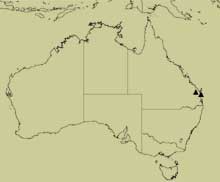Synonyms
Sticholotis cooloola Slipinski, 2004: 396.
Diagnosis
This species differs from otherwise similar S. culleni Slipinski in having the body entirely black and the pronotum densely reticulate and hardly shiny.
Description
Length 2.6-3.1 mm; Wingless; form rounded, strongly convex; pronotal margins very narrow and hardly visible from above, the elytral margins narrow, entirely visible except for the extreme apices. Surfaces between elytral punctures highly polished, spaces between pronotal and head punctures finely reticulate and feebly shiny; pronotal punctures about as large as frontal ones, somewhat denser laterally than at middle of pronotum, the elytral punctures fine dorsally becoming denser towards lateral margins but always distinctly smaller than the pronotal ones. Ground colour of dorsal and ventral surfaces blackish brown to black; labrum and appendages brown to dark brown. Head flat at middle, regularly punctuate. Clypeus weakly arcuate anteriorly, faintly upturned at anterior edge. Eyes large, coarsely facetted, dorsally separated by about 2.5 times width of an eye. Anterior lobe of prosternum sparsely punctured and not distinctly setose; metaventrite shorter than abdominal ventrite 1 with complete discrimen. Scutellum triangular and very small. Elytral epipleuron yellowish, broad and weakly concave, without distinct foveae, descending externally, with maximum width at the level of metaventrite. Abdomen: postcoxal line curved posteriad and laterad closely paralleling posterior margin for most of length, fading well before attaining lateral margin; postcoxal disc impunctate inside.
Male
Male genitalia: tegmen 1.3 times and median lobe 1.4 times as long as abdomen; each paramere with single moderately long seta at apex.
Female
Not externally different from male. Ovipositor heavily sclerotised, coxities entirely separated; spermatheca not sclerotised.
Variation
not observed.
 Distribution and Biology
Distribution and Biology
This species has been collected in lowland tropical rainforest areas along the coast, mostly in Cooloola National Park, north of Brisbane. The larva is unknown.
Click on map for larger version (use the bowser 'back arrow' to return to this page).
Species References
Slipinski, A. 2004. Revision of the Australian Coccinellidae (Coleoptera). Part 2. Tribe Sticholotidini. Annales Zoologici, 54: 389-402.
[ Top ]
